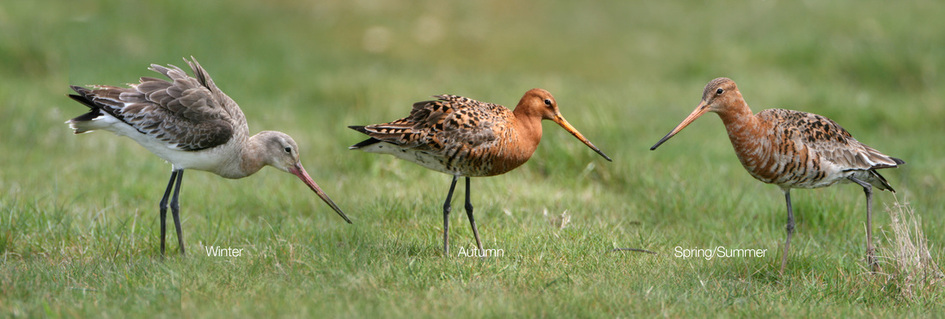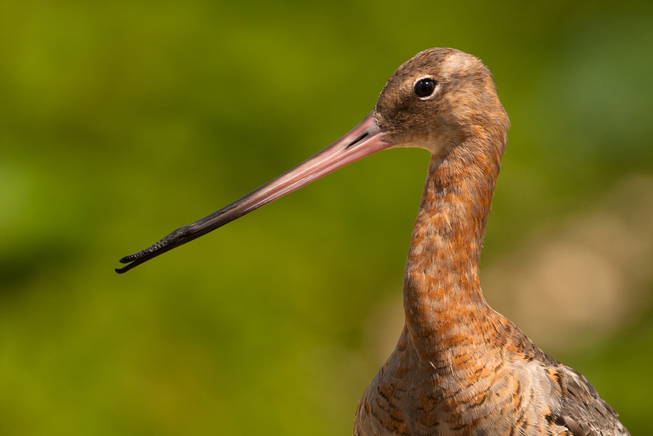Black-tailed Godwit plumage changes
|
The Black-tailed Godwit is a large wader with long bill (7.5 to 12 cm long), neck and legs. During the breeding season, the bill has a yellowish or orange-pink base and dark tip; the base is pink in winter. The legs are dark grey, brown or black. The sexes are similar, but in breeding plumage, they can be separated by the male's brighter, more extensive orange breast, neck and head. In winter, adult Black-tailed Godwits have a uniform brown-grey breast and upperparts (in contrast to the Bar-tailed Godwit's streaked back). Juveniles have a pale orange wash to the neck and breast.
In flight, its bold black and white wingbar and white rump can be seen readily. When on the ground it can be difficult to separate from the similar Bar-tailed Godwit, but the Black-tailed Godwit's longer, straighter bill and longer legs are diagnostic. Black-tailed Godwits are similar in body size and shape to Bar-taileds, but stand taller. It measures 42 cm from bill to tail with a wingspan of 70–82 cm. Males weigh around 280 g and females 340 g. The female is around 5% larger than the male, with a bill 12-15% longer. The most common call is a strident weeka weeka weeka. A study of Black-tailed Godwits in the Netherlands found a mortality rate of 37.6% in the first year of life, 32% in the second year, and 36.9% thereafter. Black-tailed Godwits are mostly monogamous; although it was not recorded in a four-year study of 50-60 pairs, bigamy was considered "probably frequent". A study of the Icelandic population showed that despite spending winter apart, pairs are reunited on their breeding grounds within an average of three days of each other. If one partner does not arrive on time, 'divorce' occurs. They nest in loose colonies. Unpaired males defend a temporary territory and perform display flights to attract a mate. Several nest scrapes are made away from the courtship territory, and are defended from other godwits. Once eggs are laid, an area of 30–50 metres around the nest is defended. The nest is a shallow scrape on the ground, usually in short vegetation. The eggs may be hidden with vegetation by the incubating parent.
The single brood of three to six eggs, coloured olive-green to dark brown, measure 55 x 37 mm and weigh 39 g each (of which 6% is shell). Incubation lasts 22–24 days and is performed by both parents. The young are downy and precocial and are brooded while they are small and at night during colder weather. After hatching, they are led away from the nest and may move to habitats such as sewage farms, lake edges, marshes and mudflats. The chicks fledge after 25–30 days. They mainly eat invertebrates, but also aquatic plants in winter and on migration. In the breeding season, prey includes include beetles, flies, grasshoppers, dragonflies, mayflies, caterpillars, annelid worms and molluscs. Occasionally, fish eggs,frogspawn and tadpoles are eaten. In water, the most common feeding method is to probe vigorously, up to 36 times per minute, and often with the head completed submerged. On land, Black-tailed Godwits probe into soft ground and also pick prey items from the surface.
|
Interesting Facts
More ID HelpBarn Owl
Bar tailed Godwit Bearded Reedling Black tailed Godwit Common Kestrel Great Spotted Woodpecker Kingfisher Knot Dunlin Reed Bunting Ringed Plover Marsh Harrier Northern Wheatear Sanderling Siskin Some British Birds of Prey Stonechat Wader ID Help Winter Thrushes Useful Links The Barn Owl Trust The Hawk and Owl Trust RSPB Underwater Photography Wildlife & Environmental Causes Scottish Wildlife National Geographic |
All images appearing on this website and its content are the copyright of John S Betts. All rights reserved.



